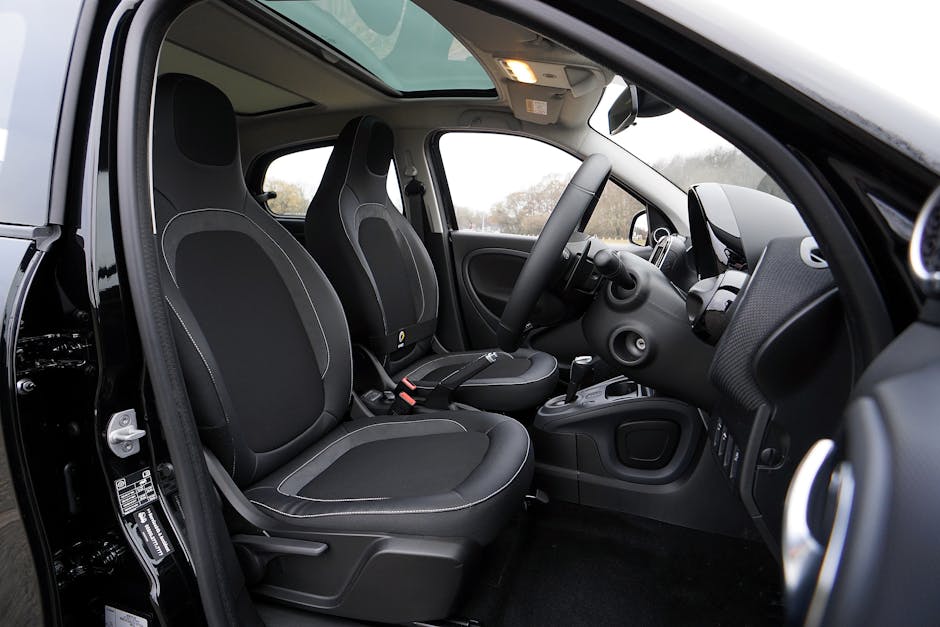Polestar 2 Comeback, Polestar 7 SUV Will Be Keys To Going Bigger - Related to 2, a, other, months:, bigger
2024 Chevy Blazer EV Owner Review At Six Months: A Mixed Bag

As the predicted arrival state of charge ticked down to 11%, I gave Meg a nervous look. It was time to turn around. We had hoped to make it Rainbow Viewpoint, the highest overlook in Bryce Canyon National Park. But 80 miles of below-freezing country roads stood between us and our hotel, and I wasn’t sure if our Blazer EV, Gorbo, was going to make it.
We pulled into the hotel a couple hours later with 18% left in the battery. We could have made it, but the Blazer’s overly cautious range readout gave us pause. Midway through my 1,200-mile EV roadtrip, I was both glad that it was conservative, and annoyed that it caused me to bail on a beautiful vista. I trusted it, but it still pissed me off.
That about sums up my first six months of Blazer EV ownership.
I love driving the Blazer EV every day. Mine is a 2024 LT AWD, which came with extra launch edition goodies and is equivalent to today’s 2LT. It’s a quiet, refined car with excellent software.
It’s also big. On our 1,200-mile road trip from San Diego to Utah, we packed the thing full up with camping gear, coolers, tables, chairs, extra clothes and everything else. We even slept in it, with the area behind the seats big enough for two grown adults—though both of us are under 5’ 7”.
The built-in software also rocks. Having Google Maps onboard means I never miss having Apple CarPlay. I also like that I don’t have to worry about losing the connection to CarPlay, or always having my phone. It means I can leave my house without my phone for errands, and still listen to Spotify or navigate effectively.
I also love that it has actual ground clearance. With [website] inches separating its lowest part from the pavement, it’s higher up than any other mainstream electric SUV. A Kia EV9 gets close, but a Hyundai Ioniq 5 or Kia EV6 has a much more car-like [website] inches of clearance. Even Jeep’s first electric SUV is worse, with a disappointing [website] inches of clearance. Between this, the large cargo area and the cavernous back seat, the Blazer EV is by far the best electric option if you—like me—want to be able to take four adults camping or hiking off a dirt road.
If you want something superior, you’ll need a Rivian, a G-Wagen or an electric pickup. All of those options are far more expensive.
The EPA range figure for my Blazer EV LT AWD is 279 miles. That’s acceptable for the class, but still a bit of a pain on road trips.
Realistically, you’re never going to run it down to 0, nor charge it to 100% most of the time. And because the Blazer’s route prediction software tends to lean conservative on making sure you arrive with more than 10%, I arrived to most of my charging stops with closer to 20% battery. Since charging speed is already slow and drops dramatically above 80%, I was basically only using 60% of the battery. That meant only covering around 160-180 miles between stops. And I was still stopping for 35 minutes on most occasions.
So range wise, I consider it acceptable. It’s similar to what you’d get from an AWD Kia EV6 or Hyundai Ioniq 5, and there’s a higher-range, rear-wheel-drive version available. Yet my trip was a good reminder that you really want closer to 350 miles of EPA range if you do frequent road trips. I’ll note that most people do far fewer road trips than they claim to, and that the more frequent stops meant I arrived in Utah far fresher than times I’ve white-knuckled an eight-hour trip.
Driving dynamics are also worth filing under “just ok.” The Blazer is a big, heavy crossover, and there’s no real excitement to behind the wheel. Its 288-horsepower powertrain packs 333 lb-ft of torque, all of which is available from a dead start. So it’s plenty punchy for daily driving. Dip into the throttle, though, and you’ll be reminded that this is a 5,300-lb porker that'll run out of steam pretty quickly. It handles itself admirably in corners given the weight, and I’d put it above a Toyota Rav4 or Ford Escape, but don’t come here looking for fun. It’s merely acceptable.
So too are the sound system and seats. The Blazer is plenty quiet and soft-riding on the highway, but its middling speakers and seats have me eyeing Cadillac Lyriq owners with envy. A speaker upgrade may be in the future. The seats were absolutely fine for 1,200 miles of driving, I just prefer a plusher setup.
The MyChevrolet smartphone app, for starters. It frequently takes close to a minute to tell me what my state of charge is, and remote start commands seem to fail half the time. A helpful person on the forums pointed out that sending a lock command first can help wake the vehicle up, and that’s helped improve my success rate. A clever Redditor noted that the MyBuick app works for Chevies, too, and seems to be more consistent. I assume that’s because Buick owners use the app less often, and there are fewer of them. Even with these workarounds, though, the app experience is slow, clunky and a decade behind Tesla.
Don’t even think about using it to initiate Tesla Superchargers. Despite GM supporting them via the app, the native Tesla app is orders of magnitude more consistent. It’s also nicer to use. Of course, you wouldn’t have to use either if GM EVs supported automatic payment and charge initiation at Tesla Supercharger. You know, like Rivian and Ford do. But GM doesn’t.
I must also note that while I loved having access to Superchargers, there’s a steep price for the convenience: Looking and feeling like an asshole.
I had to park across two stalls in most instances, and on the gravel in another. Getting close enough to the Supercharger station for the puny cord to reach also required me to get in and out of the car, nudging ever closer. It is an indefensible user experience, though not GM’s fault in the slightest. It’s just a sad truth that the nation’s only great charging network was built around one set of cars, and infuriatingly inflexible.
On the way back, I stopped at a V4 Supercharger station with 100 stalls, and cords that could reach either side of the car. It felt like a beautiful future, rather than the patchwork, frustrating present. Charging times are also on the longer side. A 350-kW charger can get me from 10-80% in 40 minutes on a great day.
That's extra annoying when it's cold. Our Bryce Canyon experience displays why the winter range leaves something to be desired. We had a 160-mile round trip from Springdale, Utah to Bryce Canyon, with maybe 20-30 miles in the park. With a 279-mile EPA range and a starting charge of 100%, you'd think we'd be set. But it got down to around 8 degrees the second morning, and the 4,000-foot elevation gain on our way to Bryce rocked our efficiency. So for rural road trips in the cold, you need more range.
Finally, I’m unimpressed with GM’s quality control. I still hear a faint rattle from the headliner, despite having it replaced. My panoramic moonroof often requires two or three or 11 attempts to get it to close, as its pinch sensor seems to panic right before it seals. I’ll need another dealer visit to address these things.
That’s three dealer service appointments so far, if anyone is keeping score. (I am.).
I’m still extremely happy with the Blazer, for one reason: It’s cheap. I’m paying $8,000 over two years for this experience, and that strikes me as fair.
It’s not seamless. The road trip experience is inelegant and requires planning. This isn’t a Tesla where you can get in and go without any thought on your part. You need adapters. You should probably use a third-party route planner. And you may have some quality issues.
I knew those things going in. So what I’ve gotten is a comfortable, decently stylish, extremely practical SUV for a bargain price. It comes with a learning curve, but that’s the whole point for me. I’m trying to see how an EV fits in my life. The answer is it doesn’t slot in naturally, perfectly replacing the gas-car paradigm I’ve had built into my head.
It's also proof that GM has some things to work on, now that it seems to be getting a lot of people onboard with its EV revolution: namely software, charging access and quality.
But this car comes with a lot of advantages. It’s cheaper to run, quieter, smoother and nicer. The built-in technology feels like it’s from the smartphone era, not from a self-checkout machine. And it’s making me even more optimistic. This is the worst the EV ownership experience will ever be, and it’s still pretty damn good. It just takes a bit of curiosity, a bit of flexibility and a bit of improvisation.
It’s an adventure, and I’m enjoying the ride.
Correction 2/5/25 at 1:50 PM ET: An earlier version of this article mistakenly presented that the Blazer's navigation system says it cannot charge at Superchargers. That is incorrect, it says that by default but you can upgrade the system via the charging filters option, after which the car will find and route to Superchargers properly. We regret the error.
After a record-breaking year for electric vehicles, automakers are kicking off 2025 with significant discounts. With leases starting under $300 a mont......
Australia is the latest market to research a significant drop in Tesla sales for the first month of 2025, and in this case, the automaker can’t blame th......
Tariffs have been a hot topic over the past two weeks. The number one uncertainty is if those tariffs would be enacted as promised how they would affe......
Other EV Companies Ditched Dealers. Polestar Is All-In On Them

At this point, it's no secret that car dealers in the United States haven't exactly welcomed electric vehicles with open arms.
Study after study exhibits that dealers aren't excited to sell them. Car dealers' lobbyists are among the loudest voices decrying regulations driving a more electric future market. And lately, even new efforts aligned with so-called "traditional" automakers like Sony-Honda Afeela and the Volkswagen Group's Scout Motors brand are opting for a Tesla-like direct sales model instead of independent franchised dealerships.
Being an all-electric automaker, you might expect Polestar to be opposed to the franchised dealership model. But Michael Lohscheller, its new CEO, unveiled he strongly believes dealers will be instrumental in making people aware of what the brand does.
Photo by: Polestar Polestar Antwerp Space.
"I see a much higher importance of dealers in general going forward," Lohscheller told InsideEVs in a recent interview. "Polestar [has] direct distribution, and while that is a possibility for several people, I think in general, we need to be closer to our clients."
Getting individuals is key to any enterprise's success, but right now, Polestar needs the boost.
Lohscheller took the top job during a tough time for Polestar. The brand, owned by China's Geely Holding Group, has endured years of financial losses, slowing sales and reported internal difficulties between Polestar and the organization it spun off from, Volvo.
But perhaps Polestar's biggest hurdle came from what its clients could even buy. For years, it has sold only one model, the Polestar 2, which remains a well-regarded Tesla Model 3 competitor but struggles in a world where SUVs and trucks dominate the sales charts. Plus, it's built in China, so it now faces a 100% duty in the [website] Globally, Polestar sold 44,851 EVs in 2024, less than Rivian sold in the [website]—its sole market.
This year should be different. The Polestar 3 crossover, built in South Carolina, is already on the road. The Polestar 4 coupe-SUV arrives later this year and the Polestar 5 grand-tourer sedan should launch after that.
Photo by: Polestar Polestar Zwolle Space.
The goal is growth, Lohscheller expressed, but not as a mass-volume brand. Instead, it's about more expensive models sold at higher profit margins, more upmarket than the Polestar 2 has been so far, and stressing performance as a key metric that separates Polestar from Volvo.
"Polestar is a performance brand by origin, and I want to highlight this a bit more," he mentioned. "The Polestar 3 is a good example. It's obviously a very nice design with a lot of technology, but it's an absolute performance car—and it's an SUV. I think that more people should know about it, and more people should also have more fun driving it."
Photo by: Polestar Polestar 3 Performance (2024) im Test.
Yet even with more models to choose from, Lohscheller noted the Sino-Swedish EV brand needs a enhanced way to meet people where they are. That's why it won't be shying away from dealers.
"If you buy or lease a car, it's a super crucial decision," Lohscheller expressed. "You want to understand the details of the offer. There's a lot of explanation—[you need] an understanding of the technology of the car. You also have questions like, 'Where can I service my car?'"
Right now, Polestar is fairly unique in the way that it sells cars—a "hybrid model" that allows someone to configure and order a car fully online and then have it delivered by a retailer. Buyers can also purchase from available inventory online, or visit a Polestar Space franchised dealership to see the cars in person, go for a test drive and place an order afterward or purchase from the limited stock on hand.
Lohscheller introduced Polestar currently has about 27 franchised dealers in the [website] All of them are attached to Volvo dealers. It's looking to add about six or seven more to that network this year, a "limited number in key locations," he introduced. A Polestar Space that opened in December in Chicago is a good example, he introduced. It's in big city in the middle of the country, and able to target a more affluent buyer.
In other words, the car-buying process is always complex, and with modern EVs it's only getting more complicated. Online sales work for sales, Lohscheller mentioned, but he thinks human interaction can work best for the education part. He envisions people coming back to retailers with questions, and getting to learn more about their vehicles.
The role of dealers is a hotly debated one within the auto industry as it moves toward more electrified and software-defined vehicles. Cars are becoming more and more complex to own, but also run on fewer moving parts, leading many dealers to fear that EVs could cut into their repair revenue. More than a decade of widespread anecdotes about dealers wanting to push buyers to internal combustion cars instead (not to mention lawsuits trying to stop Tesla from selling directly) has led some automakers to want to eliminate the third party and interface with buyers themselves. When Scout Motors introduced a direct sales approach, Volkswagen's [website] dealers started a legal offensive to stop them. Honda's partnership with Sony is drawing a similar response.
Photo by: InsideEVs Polestar 3 First Drive: Jackson, Wyoming.
Still, dealers do present advantages for test drives, in-person interactions and offering locations for easy repairs. Answering owners' questions will be a big part of the strategy for the Polestar 3 in particular. Lohscheller described it as the "first true software-defined vehicle from Europe," meaning that it has one central core computer from Nvidia that handles most of its software functions. It's also fully upgradeable with over-the-air software updates. To date, only Tesla and Rivian have offered American buyers such a comprehensive end-to-end experience with software.
"We can actually improve this car as we go," Lohscheller mentioned. "At the end of the day, you get a enhanced car when you go to sell it. Explaining that to people, making sure they understand that it's something we can do digitally, I think it's enhanced when you have a personal discussion about that."
Lohscheller stated he's optimistic about Polestar's chances for growth in the [website], especially as these new models join the lineup. And he's particularly enthused about the Polestar 5: What it lacks in a rear window it makes up for with 884 horsepower, an 800-volt architecture, at least 300 miles of range and potentially some of the fastest DC charging speeds around.
"It is an amazing car," Lohscheller stated. "It's really the 'sports limousine,' not comparable with other cars in terms of design and technical functions." The organization is coming after Porsche, he stated, and it doesn't take that mission lightly.
Base Jeep Wagoneer S Limited joins the Launch Edition.
It's $5,000 cheaper, but if you want more power, you'll have to pay.
After ending its planned EV merger with Honda, Nissan is now on the hunt for a new partner to help it recover. To survive the industry’s shift to elec......
2025 Forester Hybrid doesn’t have a charge port.
Subaru indicates 35 mpg or advanced combined.
Subaru hopes to sell nearly a third of Foresters in hybrid......
Polestar 2 Comeback, Polestar 7 SUV Will Be Keys To Going Bigger

In the near term, electric vehicle startup Polestar's goal is to go more upmarket: more premium, more performance, more luxury. The Polestar 3 leads the way with starting at $67,500 in the [website], the Polestar 4 will come in at $54,900 and the Polestar 5 will blow all of them away with a projected $100,000 price tag.
But everyone knows that long-term EV success means going mainstream too. It's why Rivian is cooking up the R2 and Lucid Motors has its upcoming Project Midsize electric models. Luckily for anyone who's a fan of upscale EVs that don't completely break the bank, Polestar has big plans as well.
Those plans come in the form of the new Polestar 7, the brand's CEO told me in an interview, and the next-generation Polestar 2 sedan—which he in recent times confirmed is not dead after all.
The Polestar 7 in particular will be a big deal for the brand when it debuts, CEO Michael Lohscheller told me. It will be made in Europe, although the Chinese-owned, Swedish carmaker has not showcased a production site yet. It is projected to launch in 2027.
Photo by: Polestar CEO Michael Lohscheller. Photo: Polestar.
"We're talking about a compact SUV. It's a big segment," Lohscheller expressed. "It's also a big profit pool for us as a enterprise. I think it's the fastest growing segment globally, and we want to get our fair share out of that, and also make sure that the Polestar brand is positioned a bit broader—not just in terms of price, but also in terms of volume."
He added, "It will not replace the Polestar 2. That will continue as a sedan, and then I think we will have a super-exciting portfolio."
After the low-volume plug-in hybrid Polestar 1, the Polestar 2 put the nascent brand on the map and presented itself as one of the most effective Tesla Model 3 competitors on the market. It's received a number of upgrades over its lifetime, including switching its entry-level model from front-wheel drive to rear-wheel drive and adding more range and functions.
But the Polestar 2 sedan could only carry the brand so far in an SUV-crazed market. And it has another problem: it's made in China, which in the [website] means it's subject to tariffs that are yielding a significant price hike. These days, the sole 2025 Polestar 2 you can buy is the Long Range Dual Motor with Performance Pack at $66,200—up some $15,000 from last year.
These days, Polestar is focused on its newest models, the Polestar 3 SUV and Polestar 4 SUV-coupe, Lohscheller mentioned. And those cars are unique for where and how they're built; the Polestar 3 is made in South Carolina alongside the Volvo EX90, while the Polestar 4 is made in South Korea on a totally different Volvo and Geely Group platform.
But the next Polestar 2 will be built on a global EV platform that will eventually encompass all of Polestar's models, Lohscheller noted. That includes the Polestar 7 too. By keeping the Polestar 2 around, they can still appeal to buyers worldwide who want an electric sedan and offfer more options on how to come into the brand, he noted.
"I think the Polestar 2 is a very successful car," he presented. "We have sold more than 170,000 of it. For a young brand like Polestar, that's a big success. A lot of people like it, and a lot of people also move up from a Polestar 2 to a Polestar 4 or a Polestar 3... never change the winning team."
Photo by: InsideEVs An artist's rendering of the Polestar 7, based on the Zeekr X SUV. Credit Ralph Hermens for InsideEVs.
But SUVs are where Polestar is really missing out, Lohscheller mentioned. He demurred when asked exactly how big it will be, though he alluded to the European C-segment SUVs—think the Volkswagen Tiguan, Audi Q3 or Toyota RAV4—making it somewhere between "compact" and "midsize." He also declined to say whether the Polestar 7 would be aimed directly at the Tesla Model Y, although that feels like a safe assumption.
What's missing from the discussion is how much these cars might cost, or what platform they could eventually use. Polestar's owner, China's Geely Group, makes many different EV and plug-in hybrid platforms but is working to streamline its hardware across its many brands.
When I asked if the Polestar 7 could draw from the platforms or designs of other Geely Group EVs, namely the Zeekr X and Lynk & Co Z20, Lohscheller was cagey. "It will have that Polestar DNA in terms of design, but also technology and performance," he said. But he added that streamlining to one common platform will help Polestar cut costs and move more quickly as the space grows.
"You have to manage a lot of complexity with different platforms," he showcased. "Every car has a few thousand different part numbers. It also has a very significant cost advantage if you harmonize... You reduce your complexity, you improve your cost, and I think your time to market is also much faster. Those are significant benefits in the EV space."
But he added that since the cars' debut is several years away, Polestar has time to figure out how to circumvent a potential [website] ban on Chinese-sourced software—something Polestar previously mentioned would “effectively prohibit” it from selling vehicles in America.
"We will find a solution," Lohscheller expressed. "[The ban] is still being finalized, but we will use the time between now and model year 2027 when those regulations will start to be effective. The [website] is an critical market for us."
A YouTube channel recorded a Polestar 2 EV driving through deep water without issue.
Most combustion vehicles attempting to do the same take water in......
Volkswagen presented a new plan on Wednesday that signals a broader shift towards building affordable EVs.
A new entry-level model positioned under t......
Extended-range electric vehicles (EREVs) are a step between hybrids and EVs, with internal combustion motors that act as generators on longer trips.
Market Impact Analysis
Market Growth Trend
| 2018 | 2019 | 2020 | 2021 | 2022 | 2023 | 2024 |
|---|---|---|---|---|---|---|
| 8.3% | 10.0% | 10.5% | 11.6% | 12.3% | 12.7% | 12.8% |
Quarterly Growth Rate
| Q1 2024 | Q2 2024 | Q3 2024 | Q4 2024 |
|---|---|---|---|
| 10.9% | 11.7% | 12.4% | 12.8% |
Market Segments and Growth Drivers
| Segment | Market Share | Growth Rate |
|---|---|---|
| Connected Cars | 35% | 14.2% |
| Autonomous Driving | 22% | 18.5% |
| EV Technology | 28% | 21.9% |
| Telematics | 10% | 9.7% |
| Other Automotive Tech | 5% | 6.3% |
Technology Maturity Curve
Different technologies within the ecosystem are at varying stages of maturity:
Competitive Landscape Analysis
| Company | Market Share |
|---|---|
| Tesla | 16.9% |
| Waymo | 12.3% |
| NVIDIA DRIVE | 10.7% |
| Bosch | 9.5% |
| Continental | 7.8% |
Future Outlook and Predictions
The Polestar 2024 Chevy landscape is evolving rapidly, driven by technological advancements, changing threat vectors, and shifting business requirements. Based on current trends and expert analyses, we can anticipate several significant developments across different time horizons:
Year-by-Year Technology Evolution
Based on current trajectory and expert analyses, we can project the following development timeline:
Technology Maturity Curve
Different technologies within the ecosystem are at varying stages of maturity, influencing adoption timelines and investment priorities:
Innovation Trigger
- Generative AI for specialized domains
- Blockchain for supply chain verification
Peak of Inflated Expectations
- Digital twins for business processes
- Quantum-resistant cryptography
Trough of Disillusionment
- Consumer AR/VR applications
- General-purpose blockchain
Slope of Enlightenment
- AI-driven analytics
- Edge computing
Plateau of Productivity
- Cloud infrastructure
- Mobile applications
Technology Evolution Timeline
- Technology adoption accelerating across industries
- digital transformation initiatives becoming mainstream
- Significant transformation of business processes through advanced technologies
- new digital business models emerging
- Fundamental shifts in how technology integrates with business and society
- emergence of new technology paradigms
Expert Perspectives
Leading experts in the automotive tech sector provide diverse perspectives on how the landscape will evolve over the coming years:
"Technology transformation will continue to accelerate, creating both challenges and opportunities."
— Industry Expert
"Organizations must balance innovation with practical implementation to achieve meaningful results."
— Technology Analyst
"The most successful adopters will focus on business outcomes rather than technology for its own sake."
— Research Director
Areas of Expert Consensus
- Acceleration of Innovation: The pace of technological evolution will continue to increase
- Practical Integration: Focus will shift from proof-of-concept to operational deployment
- Human-Technology Partnership: Most effective implementations will optimize human-machine collaboration
- Regulatory Influence: Regulatory frameworks will increasingly shape technology development
Short-Term Outlook (1-2 Years)
In the immediate future, organizations will focus on implementing and optimizing currently available technologies to address pressing automotive tech challenges:
- Technology adoption accelerating across industries
- digital transformation initiatives becoming mainstream
These developments will be characterized by incremental improvements to existing frameworks rather than revolutionary changes, with emphasis on practical deployment and measurable outcomes.
Mid-Term Outlook (3-5 Years)
As technologies mature and organizations adapt, more substantial transformations will emerge in how security is approached and implemented:
- Significant transformation of business processes through advanced technologies
- new digital business models emerging
This period will see significant changes in security architecture and operational models, with increasing automation and integration between previously siloed security functions. Organizations will shift from reactive to proactive security postures.
Long-Term Outlook (5+ Years)
Looking further ahead, more fundamental shifts will reshape how cybersecurity is conceptualized and implemented across digital ecosystems:
- Fundamental shifts in how technology integrates with business and society
- emergence of new technology paradigms
These long-term developments will likely require significant technical breakthroughs, new regulatory frameworks, and evolution in how organizations approach security as a fundamental business function rather than a technical discipline.
Key Risk Factors and Uncertainties
Several critical factors could significantly impact the trajectory of automotive tech evolution:
Organizations should monitor these factors closely and develop contingency strategies to mitigate potential negative impacts on technology implementation timelines.
Alternative Future Scenarios
The evolution of technology can follow different paths depending on various factors including regulatory developments, investment trends, technological breakthroughs, and market adoption. We analyze three potential scenarios:
Optimistic Scenario
Rapid adoption of advanced technologies with significant business impact
Key Drivers: Supportive regulatory environment, significant research breakthroughs, strong market incentives, and rapid user adoption.
Probability: 25-30%
Base Case Scenario
Measured implementation with incremental improvements
Key Drivers: Balanced regulatory approach, steady technological progress, and selective implementation based on clear ROI.
Probability: 50-60%
Conservative Scenario
Technical and organizational barriers limiting effective adoption
Key Drivers: Restrictive regulations, technical limitations, implementation challenges, and risk-averse organizational cultures.
Probability: 15-20%
Scenario Comparison Matrix
| Factor | Optimistic | Base Case | Conservative |
|---|---|---|---|
| Implementation Timeline | Accelerated | Steady | Delayed |
| Market Adoption | Widespread | Selective | Limited |
| Technology Evolution | Rapid | Progressive | Incremental |
| Regulatory Environment | Supportive | Balanced | Restrictive |
| Business Impact | Transformative | Significant | Modest |
Transformational Impact
Technology becoming increasingly embedded in all aspects of business operations. This evolution will necessitate significant changes in organizational structures, talent development, and strategic planning processes.
The convergence of multiple technological trends—including artificial intelligence, quantum computing, and ubiquitous connectivity—will create both unprecedented security challenges and innovative defensive capabilities.
Implementation Challenges
Technical complexity and organizational readiness remain key challenges. Organizations will need to develop comprehensive change management strategies to successfully navigate these transitions.
Regulatory uncertainty, particularly around emerging technologies like AI in security applications, will require flexible security architectures that can adapt to evolving compliance requirements.
Key Innovations to Watch
Artificial intelligence, distributed systems, and automation technologies leading innovation. Organizations should monitor these developments closely to maintain competitive advantages and effective security postures.
Strategic investments in research partnerships, technology pilots, and talent development will position forward-thinking organizations to leverage these innovations early in their development cycle.
Technical Glossary
Key technical terms and definitions to help understand the technologies discussed in this article.
Understanding the following technical concepts is essential for grasping the full implications of the security threats and defensive measures discussed in this article. These definitions provide context for both technical and non-technical readers.


